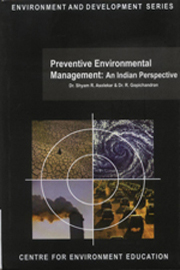Book contents
- Frontmatter
- Foreword
- Acknowledgements
- Contents
- List of Figures
- Summary
- Preface
- The Contents
- Preventive Environmental Management Tools
- Preventive Environmental Management Initiatives
- Overarching Issues
- 17 Integrated Policy for Production and Consumption: A Proposal
- 18 Innovative Approaches Toward Capacity Building
- 19 Nexus Between Trade and Environment
- References
- Bibliography
- Web-Resources
- About the Authors
- Abbreviations
- Index
17 - Integrated Policy for Production and Consumption: A Proposal
from Overarching Issues
Published online by Cambridge University Press: 05 November 2011
- Frontmatter
- Foreword
- Acknowledgements
- Contents
- List of Figures
- Summary
- Preface
- The Contents
- Preventive Environmental Management Tools
- Preventive Environmental Management Initiatives
- Overarching Issues
- 17 Integrated Policy for Production and Consumption: A Proposal
- 18 Innovative Approaches Toward Capacity Building
- 19 Nexus Between Trade and Environment
- References
- Bibliography
- Web-Resources
- About the Authors
- Abbreviations
- Index
Summary
Undoubtedly, economic growth is a means to attain a better standard of living and therefore an essential and desirable feature of India's development model. It is also recognized that practices of domestic and international trade do significantly affect the quality of environment via the process of externalization of costs of environmental protection. These issues assume even larger significance in the present times when the developing countries (including India) are making special efforts to promote international trade. Often these countries end up manufacturing only those commodities that are known to generate rather large environmental footprints.
It is in this context the environmentalists in Tndia and elsewhere are asking, “Are we importing pollution while exporting goods?” Khan, et al. [2001] have argued that although the textile and leather are polluting sectors in Pakistan; approximate estimates of benefits of pollution mitigation suggest levels of 0.5% and 0.04% of gross domestic product (GDP) for textile and leather sectors, respectively. These levels far exceeded the cost of mitigation (0.12% and 0.005% of GDP, respectively) as of 1996.
Accelerated economic and industrial growth over the past few decades has been accompanied by pollution of our ambient atmosphere and waters apart from inflicting damage to our soils, ground water, and public health. Estimates reported by Brandon, et al. [1995] place the value of damage at approximately 4.5% of the Indian GDP (34,000 crores). The environmental cost of water pollution in the industrial megaeity of Chongqing in China has been reported by Yongguan, et al. [2001].
- Type
- Chapter
- Information
- Preventative Environmental ManagementAn Indian Perspective, pp. 473 - 490Publisher: Foundation BooksPrint publication year: 2005



